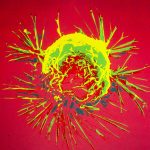Definition
noun
A sequence of amino acid residues bound at the amino terminus of a nascent protein during protein translation, which when recognized by the signal recognition particle results in the transport of the nascent protein to the organelle of destination
Supplement
During protein translation, a specific protein is being produced through the action of mRNA and ribosome. A signal sequence comprised of amino acid residues may be produced eventually and bound as part of the growing protein.
The signal sequence is like a “flag” bound at the amino terminus of the emerging protein. This “flag” signals the transport mechanism of the cell to prompt them as to where the emerging protein should go. This “flag” is recognized by signal recognition particle (SRP) located freely in the cytoplasm or attached to the ribosome.
The SRP interacts with the signal sequence, which leads to the transient arrest of translation. At this time, the protein (not yet fully formed) is transported to the destination organelle, e.g. endoplasmic reticulum especially when the protein is for secretion. Upon docking to the membrane of the endoplasmic reticulum the SRP detaches and this leads to the continuation of protein translation, and eventually to the maturation of protein in which the signal sequence is cleaved by the signal peptidase.
Also called:
- leader peptide
- signal peptide
See also:
Reference(s):
- Duffaud GD, Lehnhardt SK, March PE, Inouye M. 1985. Structure and Function of the Signal Peptide. In: Knauf PA, Cook JS. Membrane protein biosynthesis and turnover. Florida: Academic Press. P.65-104.


